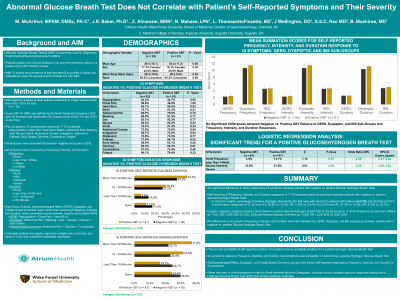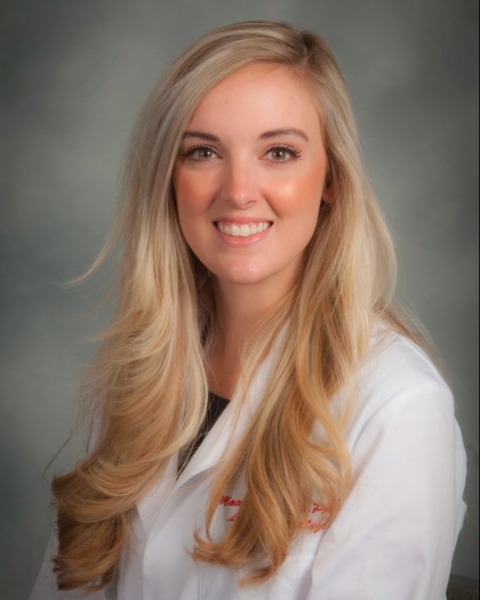Back


Poster Session A - Sunday Afternoon
Category: Small Intestine
A0637 - Abnormal Glucose Breath Test Does Not Correlate With Patient’s Self-Reported Symptoms and Their Severity
Sunday, October 23, 2022
5:00 PM – 7:00 PM ET
Location: Crown Ballroom

Has Audio

Mackenzie Jarvis, MPAM, PA-C, DMSc
Atrium Health Wake Forest
Charlotte, NC
Presenting Author(s)
Mackenzie McArthur, MPAM, PA-C, DMSc1, Jason Baker, PhD2, Zaida Almanzar, RN1, Lisandra Thomazetto Finzetto, BA3, Jennifer Wellington, DO1, Baharak Moshiree, MD, MSCI, FACG3, Satish Rao, MD4
1Atrium Health Wake Forest, Charlotte, NC; 2Anxrobotics, Foley, AL; 3Atrium Health, Charlotte, NC; 4Augusta University, Augusta, GA
Introduction: Glucose Hydrogen Breath Testing (GBT) is commonly used for diagnosing Small Intestinal Bacterial Overgrowth (SIBO). However, patients present with clinical symptoms (sx) and their predictive value for a positive (pos) GBT remains unclear. AIM: To assess the prevalence of self-reported GI sx profiles in adults with unexplained upper GI symptoms and correlate this with GBT.
Methods: We retrospectively analyzed all adult patients presenting to a single medical center from 6/20 –12/21 for GBT. A pos GBT for SIBO was defined by the North American Consensus (≥20 ppm H2 increase over basal within 90 minutes (mins) and/or ≥10 ppm CH4 at any time). Pts completed a GI questionnaire assessing 17 key sxs: regurgitation (RG), chest pain (CP), heartburn (HB), belch (BH), abdominal pain (AP), bloating (BT), gas (GS), nausea (NA), vomit (VT), abdominal cramps (AC), indigestion (ID), distension (DN), fullness (FL), early satiety (ES), diarrhea (DR), constipation (CN), and fatigue (FT). Sxs measured by frequency (None, < 1/week (wk), 1/wk, ≥ 1/wk), intensity (None, Mild, Moderate, Severe), and duration (None, < 10 mins, 10 – 30 mins, ≥ 30 mins). Sub-groups, GERD, Dyspeptic, and IBS were constructed assessing the mean summation scores for Frequency, Intensity, and Duration between negative (neg) and pos GBTs. Univariate analysis and logistic regression analysis was performed. A p-value of < 0.05 was considered statistically significant.
Results: We evaluated 184 pts, mean age of 51.7 (18 – 85), 78.3% female, 82.8% Caucasian, and mean BMI of 27.2. No significant differences were seen between GI sx frequency and intensity categories for pts with GBT neg and pos groups. A trend for a higher percentage of pos GBT pts reporting FL (p=0.09) and DR (p=0.07) in sx duration categories of 10 -30 mins (FL: 30.8% vs. 27.5%; DR: 31.8% vs. 23.4%) and ≥ 30 mins (FL: 51.3% vs. 41.3%; DR: 37.2% vs. 22.1%) was noted. Regression analysis showed a trend toward a pos GBT for VT frequency of Less than 1/wk: (p = 0.07; OR = 2.99; 95% CI: 0.91, 9.83) and NA intensity of Severe: (p = 0.09; OR = 2.24; 95% CI: 0.86, 5.84). No differences were seen between the GERD, Dyspeptic, and IBS sub-groups.
Discussion: The pre-test predictability of GI symptoms as it relates to a pos or neg GBT is poor. The yield for a pos GBT varies between 31%-55% and depends on age. In routine practice, when the index of clinical suspicion is high for SIBO, clinicians should consider objective testing with GBT rather than empiric antibiotic treatment.

Disclosures:
Mackenzie McArthur, MPAM, PA-C, DMSc1, Jason Baker, PhD2, Zaida Almanzar, RN1, Lisandra Thomazetto Finzetto, BA3, Jennifer Wellington, DO1, Baharak Moshiree, MD, MSCI, FACG3, Satish Rao, MD4. A0637 - Abnormal Glucose Breath Test Does Not Correlate With Patient’s Self-Reported Symptoms and Their Severity, ACG 2022 Annual Scientific Meeting Abstracts. Charlotte, NC: American College of Gastroenterology.
1Atrium Health Wake Forest, Charlotte, NC; 2Anxrobotics, Foley, AL; 3Atrium Health, Charlotte, NC; 4Augusta University, Augusta, GA
Introduction: Glucose Hydrogen Breath Testing (GBT) is commonly used for diagnosing Small Intestinal Bacterial Overgrowth (SIBO). However, patients present with clinical symptoms (sx) and their predictive value for a positive (pos) GBT remains unclear. AIM: To assess the prevalence of self-reported GI sx profiles in adults with unexplained upper GI symptoms and correlate this with GBT.
Methods: We retrospectively analyzed all adult patients presenting to a single medical center from 6/20 –12/21 for GBT. A pos GBT for SIBO was defined by the North American Consensus (≥20 ppm H2 increase over basal within 90 minutes (mins) and/or ≥10 ppm CH4 at any time). Pts completed a GI questionnaire assessing 17 key sxs: regurgitation (RG), chest pain (CP), heartburn (HB), belch (BH), abdominal pain (AP), bloating (BT), gas (GS), nausea (NA), vomit (VT), abdominal cramps (AC), indigestion (ID), distension (DN), fullness (FL), early satiety (ES), diarrhea (DR), constipation (CN), and fatigue (FT). Sxs measured by frequency (None, < 1/week (wk), 1/wk, ≥ 1/wk), intensity (None, Mild, Moderate, Severe), and duration (None, < 10 mins, 10 – 30 mins, ≥ 30 mins). Sub-groups, GERD, Dyspeptic, and IBS were constructed assessing the mean summation scores for Frequency, Intensity, and Duration between negative (neg) and pos GBTs. Univariate analysis and logistic regression analysis was performed. A p-value of < 0.05 was considered statistically significant.
Results: We evaluated 184 pts, mean age of 51.7 (18 – 85), 78.3% female, 82.8% Caucasian, and mean BMI of 27.2. No significant differences were seen between GI sx frequency and intensity categories for pts with GBT neg and pos groups. A trend for a higher percentage of pos GBT pts reporting FL (p=0.09) and DR (p=0.07) in sx duration categories of 10 -30 mins (FL: 30.8% vs. 27.5%; DR: 31.8% vs. 23.4%) and ≥ 30 mins (FL: 51.3% vs. 41.3%; DR: 37.2% vs. 22.1%) was noted. Regression analysis showed a trend toward a pos GBT for VT frequency of Less than 1/wk: (p = 0.07; OR = 2.99; 95% CI: 0.91, 9.83) and NA intensity of Severe: (p = 0.09; OR = 2.24; 95% CI: 0.86, 5.84). No differences were seen between the GERD, Dyspeptic, and IBS sub-groups.
Discussion: The pre-test predictability of GI symptoms as it relates to a pos or neg GBT is poor. The yield for a pos GBT varies between 31%-55% and depends on age. In routine practice, when the index of clinical suspicion is high for SIBO, clinicians should consider objective testing with GBT rather than empiric antibiotic treatment.

Figure: Mean Summation Scores for Self-Reported Frequency, Intensity, and Duration Responses to GI Symptoms Relative to the Gastroesophageal Reflux Disease (GERD), Dyspeptic, and irritable bowel syndrome (IBS) Groups.
Prevalence of Positive Glucose Breath Test (GBT) Among Age Cohorts and Glucose Breath Test Measurements
Prevalence of Positive Glucose Breath Test (GBT) Among Age Cohorts and Glucose Breath Test Measurements
Disclosures:
Mackenzie McArthur: Abbvie – Speakers Bureau. Coloplast – Advisory Committee/Board Member. Evoke – Advisory Committee/Board Member. Phathom Pharmaceuticals – Advisory Committee/Board Member, Speakers Bureau. Salix Pharmaceuticals – Advisory Committee/Board Member, Speakers Bureau. Sanofi – Advisory Committee/Board Member.
Jason Baker: Anxrobotics – Employee.
Zaida Almanzar indicated no relevant financial relationships.
Lisandra Thomazetto Finzetto indicated no relevant financial relationships.
Jennifer Wellington indicated no relevant financial relationships.
Baharak Moshiree indicated no relevant financial relationships.
Satish Rao: Salix Pharmaceuticals – Grant/Research Support. Vibrant – Advisor or Review Panel Member. Vibrant – Clinical Advisory Board.
Mackenzie McArthur, MPAM, PA-C, DMSc1, Jason Baker, PhD2, Zaida Almanzar, RN1, Lisandra Thomazetto Finzetto, BA3, Jennifer Wellington, DO1, Baharak Moshiree, MD, MSCI, FACG3, Satish Rao, MD4. A0637 - Abnormal Glucose Breath Test Does Not Correlate With Patient’s Self-Reported Symptoms and Their Severity, ACG 2022 Annual Scientific Meeting Abstracts. Charlotte, NC: American College of Gastroenterology.
